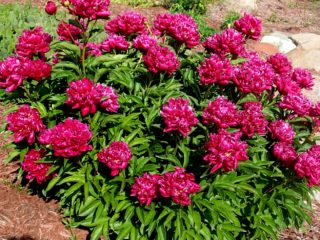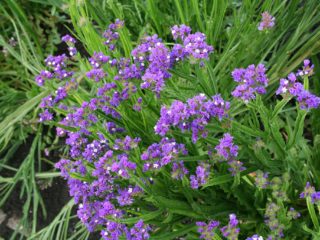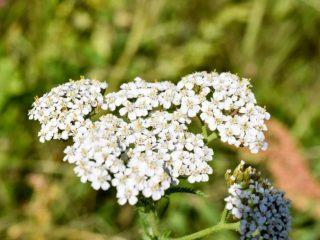Peony (Paeónia) is a deciduous perennial herbaceous shrub. There are several reasons why peony leaves turn red, but the change in color shades is not always caused by pathology. The leaves often turn red on young peony sprouts, but as the bush develops, they gradually become green.
Why do the peony leaves turn red?
The green leaves of mature plants turn red for various reasons. For example, this can happen as a result of infection with diseases or changes in climatic conditions.
Lack of sunlight
Very often, peony leaves turn red due to insufficient natural sunlight. For normal growth and flowering, the shrub requires more than six hours of exposure to ultraviolet rays daily.
In the afternoon, light shading is desirable for the crop; some plant varieties grow and enter the decorative period even in openwork shade. But complete darkening has a detrimental effect on all varieties of flowers; the appearance of the bush significantly worsens, incl. green leaves turn red.
If the peony leaves are covered with red spots, this could be due to overexposure to direct rays of the sun in the afternoon.

Green plates can become severely sunburned, causing them to develop dark spots and turn red.
Sudden weather change
The plant is sensitive to weather changes. Its color changes with climate change. The green leaves of peonies turn red when there is a sharp change from long, cool and cloudy weather to hot sunny days.
Soil change
Peonies grow effectively in different soils, but the most favorable for shrubs is slightly acidic and neutral soil. Some varieties of perennial plants grow actively in slightly alkaline soils. Therefore, it is recommended to select a place for planting sprouts taking into account the type of flower.
Reddening of peony leaves is caused by excessive soil deoxidation (changes in pH). The leaves turn red both when the land area dries out and when the crop is frequently watered (waterlogged soil).
Nutrient deficiency
As the plant develops, the composition of the soil changes, and the amount of useful components in it is significantly reduced.The fertilizer, which is applied to the planting hole for the effective development of the root system of the flower and the rapid growth of the bush, completely releases nutrients in about 2 years. Due to insufficient feeding, the leaves of adult bushes turn red.

The main useful components necessary for the proper development and growth of peonies
To prevent green foliage from turning red, plants require the following substances:
- potassium;
- phosphorus;
- manganese;
- iron.
Peony leaves can also turn burgundy due to a lack of nitrogen in the soil. In spring, this chemical element is one of the main elements for effective healthy plant growth. But it is not recommended to oversaturate the soil with nitrogen. This will lead to intensive growth of green bushes and anthocyanin degradation.
Diseases
The green leaves of a perennial flower turn red, growing in an optimal climate, fertilized soil, incl. with proper care, in case of damage by fungal plant diseases.
Fusarium rot
A common disease of peonies when the leaves turn red.
Symptoms of fusarium rot:
- the appearance of burgundy spots on green plates;
- rapid drying, falling leaves;
- stopping the growth of perennial shrubs;
- the plant stops blooming.
Gray mold (botrytis)
This disease poses a serious threat to peonies.

A bush affected by gray rot not only turns red in its leaves, but it may even die
The disease manifests itself as plaques on foliage, buds and shoots. This fungal disease is caused by the activity of the fungus Botrytis paeoniae. The green plates also turn red.
Causes of the disease:
- excessive concentration of nitrogen in the soil;
- poor ventilation;
- placement in the shade;
- excess humidity;
- distribution of fungal spores among flowers.
Symptoms of a fungal disease:
- the appearance of brown (burgundy) spots on the foliage of peonies;
- drying (withering) of the bush;
- rotting of shoots, buds, flowers;
- the appearance of a black coating at the bottom of the stem, breaking off (falling);
- the appearance of a gray coating on dark spots during humid and warm weather.
Treatment and prevention:
- all affected leaves, stems, buds and peony flowers are removed;
- reduce watering of the plant, since a humid environment is favorable conditions for the rapid development of fungal pathology.
Rust

If the leaves of a peony turn red in the fall, the bush is infected with a fungal rust pathogen.
Manifestations:
- the plant does not overwinter well;
- the bush dries out, the greenery turns yellow;
- leaves turn red;
- grows poorly next season;
- On the lower side of the foliage, pads with fungal spores form; the upper side becomes covered with brown spots.
The fungus is highly resistant to frost; in the spring its activity doubles, and it is capable of completely destroying a flower garden.
Curling leaves
Peonies have a fairly acute reaction to watering. The plant is negatively affected by both a lack and an excess of moisture.

When the roots are affected by rot, the green foliage turns brown (red) and disappears
Other reasons why flower leaves curl:
- damage by fungal and viral diseases;
- damage to the root system by harmful insects;
- lack of potassium in the soil;
- plant shading.
What to do if peony leaves turn red
To prevent the formation of burgundy spots on a peony, you need to provide sufficient sunlight before noon and slight shading in the afternoon:
- If the lack of ultraviolet radiation occurs due to an artificial fence (fence), it must be removed.
- If the flower garden is located on an open plot of land without fences, trees or buildings, it will receive sunlight all day long. In the afternoon, it is recommended to protect peonies with a fabric awning that allows air to pass through.
The most radical option is to transplant the shrub to another place with the most favorable natural light.
Timely feeding
Peonies need sufficient quantities of organic fertilizers (humus, compost, etc.). Feed the soil in the spring during the period of active crop growth.
To prevent the leaves of a perennial flower from turning red due to lack of nutrients, it is recommended to periodically feed the soil:
- nitrogen-containing compounds (urea) in the spring after the snow cover melts;
- fertilizers containing potassium and phosphorus at the stage of filling peony buds;
- flowering stimulants immediately before flower opening;
- phosphorus-potassium fertilizing 2 weeks after flowering;
If peony leaves turn red, you can use universal fertilizers:
- wood ash - introduced into loosened soil or scattered around the bush directly on top of the soil;
- leaf compost - dry fertilizer is spread on the ground around the bush;
Treatment of peonies for fusarium rot
At the early stage of damage to peonies by fusarium rot, which causes reddening of the leaves:
- treat the bushes with 3% Bordeaux mixture;
- dig up the bush at the end of August, thoroughly wash the roots, remove damaged areas, and treat the pruning areas with charcoal;
- transplant peonies to another place. The soil is pre-treated with manganese solution.
Treatment of gray rot
Stems and leaves affected by gray rot are cut off and destroyed.

In spring, peony bushes are treated with one percent Bordeaux mixture
Fungicides to combat the disease: Planriz, Vectre, Maxim, Mikosana, Chistotsvet, Skor.
Preventive actions:
- Peonies are planted in a lighted area with loose, permeable soil, at a distance from other shrubs and garden trees.
- For cultivation, flower varieties are selected that are most resistant to climate change, plant diseases and harmful insects.
- Before planting in open ground, peony roots are heated in warm water (+60-70ºС) for 10 minutes, and the bottom of the holes is covered with wood ash.
- The soil around the bush is periodically loosened.
- For wintering, short pruning of plant shoots is performed.
- When replanting a bush, rotten roots are cut with a sharp knife, the blade of which is first disinfected, then the wounds are treated with brilliant green and charcoal.
Folk remedy for peony diseases

The most popular folk remedy for peony diseases is celandine.
Recipe for medicinal tincture:
- collect 500 grams of fresh grass;
- infuse celandine for 2 hours in 5 liters of boiling water;
- filter through cheesecloth.
The prepared solution is used to treat infected peony bushes every 5 days until the symptoms of the disease disappear.
Rust treatment
Measures to eliminate rust fungus:
- the affected leaves of the plant are cut off;
- bush waste is burned;
- the soil is dug up deeply and thoroughly;
- after the sprouts appear in early spring, 2-3 cm of the top layer of soil is removed, and fresh cleaned soil mixed with sand is filled in instead;
- treated with a solution: 10 liters of water + 3 tbsp. tar soap or ammonia.
When the disease is activated, fungicides are also used:
- Bordeaux mixture - 10 liters of water + 100 g of copper sulfate, lime;
- copper oxychloride – 10 liters of water + 40 g of product;
- colloidal sulfur – 10 liters of water + 100 g of substance.
Harmful insects
If peonies are not taken care of, they are affected not only by plant diseases, but also by various harmful insects. They also need to be fought.
Bronze beetles

Parasitic beetles with shiny golden backs are most active between May and August
They eat leaves, branches, petals of peonies.
Measures to combat beetles:
- removing parasites from bushes manually in the morning every day until they disappear completely;
- during the period of pest pupation (late summer), the soil is loosened;
- peonies are sprayed during budding with special chemical compounds or tincture of tomato tops.
Root-knot nematodes
These harmful insects damage the roots of flower bushes. They are recognized by nodular swellings in which small worms are localized.
Pest control methods:
- peonies affected by nematodes are dug up and burned;
- the soil is treated with one percent formaldehyde;
- for growing perennials, planting material is carefully selected;
- the land plot for planting is dug up deeply;
- During harvesting at the end of the summer season, plant remains are disposed of.
Turf ant

The sweet syrup of peonies strongly attracts turf ants.
These are harmful insects with a yellow-red body. They eat leaves and flower petals.
To prevent the flower garden from being damaged by ants:
- sprinkle the soil around the bush with chopped onions or garlic cloves;
- bushes and soil are treated with repellents;
- The stems are rubbed with garlic gruel, the smell of which is very good at repelling pests.
Conclusion
The reasons why peony leaves turn red vary widely. This may be a sudden change in weather conditions, insufficient or excessive exposure to ultraviolet rays of the sun, or damage to the plant by fungal diseases or harmful insects. Therefore, flower shrubs need to be properly cared for - watered, fed and treated with special products against diseases and pests.
















